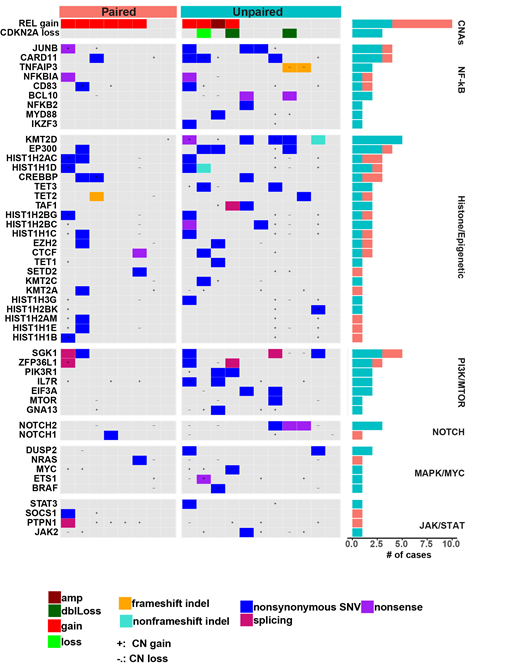Introduction:
Transformed nodular lymphocyte predominant Hodgkin lymphoma (tNLPHL) with a typical diffuse large B-cell lymphoma (DLBCL) pattern is rare and not well studied by genomic analysis. We employed next generation sequencing and copy number analysis (CNA) to examine the pathogenesis of these tumors.
Methods:
We identified 19 cases of tNLPHL with DLBCL morphology and sheet-like growth from three institutions. NLPHL preceded transformation in 5 patients and was concurrent with transformation in 11. All cases of tNLPHL were sequenced using a targeted sequencing panel of 356 genes that included commonly mutated genes associated with lymphoma. We had 8 cases with matched germline DNA. We also performed CNA using Oncoscan on 18 cases of tNLPHL. Library preparation with paired end 100 bp sequencing and 6-10 million reads/case was performed on an Illumina HiSeq 2500. Fisher's exact test was used to compare the role of mutations in tNLPHL to three large series of de novo DLBCL.
Results:
The CNA showed frequent gains in REL and loss of CDKN2A. Mutation analysis showed frequent mutations of genes associated with the PI3K pathway such as SGK1 (26%), ZFP36L1 (16%), PIK3R1 (11%), and IL7R (11%), the NF-kB pathway such as CARD11 (21%), JUNB (21%), BCL10 (11%), NFKBIA (11%), TNFAIP3 (11%), histone/DNA modification such as KMT2D (26%), EP300 (21%), TET2 (11%), TET3 (11%), and the NOTCH pathway such as NOTCH2 (16%), NOTCH1 (1 case), CTBP2 (11%). Mutations in genes involved in immune surveillance and TP53 abnormalities were infrequent. Compared to de novo DLBCL, mutations in IL7R (10.5% vs 0.6%, p=0.03), JUNB (21% vs 4.2%, p=0.01), and SMARCAL1 (11% vs 0%, p=0.01) were significantly higher in tNLPHL than in germinal center B-cell (GCB) subtype of DLBCL.
Conclusion:
The mutational spectrum of tNLPHL resembles the DLBCL Cluster 4 of Chapuy et al (Nat Med, 2018), which were primarily GCB-DLBCL with frequent mutations in the PI3K pathway (SGK1), NF-kB pathway (CARD11, JUNB), and histone modification. The mutational spectrum is also distinctive in having frequent mutations that are not often seen together in DLBCL, such as TET2, JUNB and NOTCH2. Distinct from transformed follicular lymphoma, TP53 abnormalities and mutations affecting immune surveillance are uncommonly observed. This study provides new insights into the biology of tNLPHL and may highlight potential targets for therapy in the future.
Herrera:Adaptive Biotechnologies: Consultancy; Bristol-Myers Squibb: Consultancy, Research Funding; Gilead Sciences: Consultancy, Research Funding; Seattle Genetics: Consultancy, Research Funding; AstraZeneca: Research Funding; Merck: Consultancy, Research Funding; Genentech, Inc.: Consultancy, Research Funding; Pharmacyclics: Research Funding; Immune Design: Research Funding; Kite Pharma: Consultancy, Research Funding.
Author notes
Asterisk with author names denotes non-ASH members.


